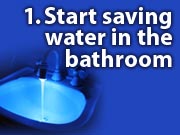
Inside your house, bathroom facilities claim nearly 75% of the water used. Limiting water use in the bathroom is a great place to start your conservation efforts.
2. Never pour water down the drain when there may be another use for it such as watering a plant or garden, or for cleaning around your home.
3. Verify that your home is leak free. Many homes have hidden water leaks. Read your water meter before and after a 2-hour period when no water is being used. If the meter does not read exactly the same, there is a leak.
4. Retrofit all household faucets by installing aerators with flow restrictors to slow the flow of water.
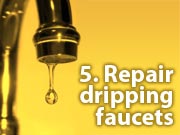
Repair dripping faucets by replacing washers. If your faucet is dripping at a rate of one drop per second, you can expect to waste 2,700 gallons per year. This adds to the cost of water and sewer utilities and adds to your water bill.
6. Check for toilet tank leaks by adding food coloring to the tank. If the toilet is leaking, color will appear in the toilet bowl within 30 minutes. Check the toilet for worn out, corroded or bent parts. Most replacement parts are inexpensive, readily available, and easily installed. (Flush as soon as test is done since food coloring may stain tank.)
7. If the toilet handle frequently sticks in the flush position letting water run constantly, replace or adjust it.

Replace your showerhead with an ultra-low-flow version. Some units are available that allow you to cut off the flow without adjusting the water temperature knobs.
|
9. Install a toilet dam or displacement device such as a bag or bottle to cut down on the amount of water needed for each flush. Be sure installation does not interfere with the operating parts. When purchasing new or replacement toilets, consider low-volume units which use less than half the water of older models. In many areas, low-volume units are required by local building codes.
10. In the shower, turn water on to get wet; turn off to lather up; then turn back on to rinse off. Repeat when washing your hair.
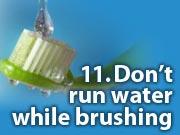
Don’t let water run while shaving or washing your face. Brush your teeth first while waiting on water to get hot, then wash or shave after filling the basin.
12. Operate automatic dishwashers and clothes washers only when they are fully loaded. Set the water level for the size of load you are using.
13. When washing dishes by hand, fill one sink or basin with soapy water. Quickly rinse under a slow-moving stream from the faucet.
14. Store drinking water in the refrigerator. Don’t let the tap run while you are waiting for cool water to flow.
15. Do not use running water to thaw meat or other frozen foods. Defrost food overnight in the refrigerator or use the defrost setting on your microwave.
16. Kitchen sink disposals require lots of water to operate properly. Start a compost pile as an alternate method of disposing of food waste instead of using a garbage disposal. Garbage disposals also can add 50 percent to the volume of solids in the sewer system or they can lead to problems with a septic tank.
17. Consider installing an instant water heater on your kitchen sink so you don’t have to let the water run while it heats up. This will reduce water heating costs for your household.
18. Insulate your water pipes. You’ll get hot water faster and avoid wasting water while it heats up.
19. Install water softening systems only when necessary. Save water and salt by running the minimum amount of regenerations necessary to maintain water softness. Turn softeners off while on vacation. |
20. If you have a well at home, check your pump periodically. Listen to hear if the pump kicks on and off while water is not being used. If it does, you have a leak.
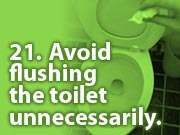
Dispose of tissues, insects and other similar waste in the trash rather than the toilet.
22. Teach children to turn water faucets off tightly after use.
23. Use drought tolerant plants and grasses for landscaping and reduce grass covered areas.
24. Be aware of and follow all water conservation and water shortage rules in effect in your community. Don’t assume – even if you get your water from a private well – that you need not observe good water use rules. Every drop counts.
25. Encourage your employer to promote water conservation in the workplace. Suggest that water conservation be put in employee orientation and training programs.
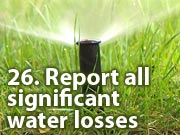
broken pipes, open hydrants, errant sprinklers, abandoned free-flowing wells, etc. to the property owner, local authorities or your water management district.
27. Encourage your school system and local government to help develop and promote a water conservation ethic among children and adults.
28. Support projects that will lead to an increased use of reclaimed wastewater for irrigation and other uses.
29. Support efforts and programs that create a concern for water conservation amongst tourists and visitors to our state. Make sure your visitors understand the need for, and the benefits of, water conservation.
30. Encourage your friends and neighbors to be part of a water-conscious community. Promote water conservation in community newsletters, on bulletin boards and by example. Encourage your friends, neighbors and co-workers to “do their part.”
|